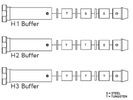Folks act like AR-15’s are built to be riding on a tight rope, but in reality, we have a huge highway of operability.
Why do so many AR’s “run right” with carbine weight buffers and springs? Because that combination is undermassed for the commonly overgassed system, so they’ll fire and feed, but they’re running harder than they should and recoil impulse feels like garbage. Colt uses heavy buffers in their standard design for a reason - because that’s what the rifle really should be using. But commercial manufacturers have realized they get less complaints when rifles ALWAYS feed, even if they are overdriving their actions, so they use “carbine weight” buffers as standard equipment - and the rifles are overgassed. All we are doing is balancing gas and mass, so many folks observe an overGASSING problem, meaning too much flow is being redirected to the action instead of driving the bullet, but then folks throw more weight at the reciprocating mass instead of fixing the gas… Throttle the gas, you’ll get the ejection you want. Better still, use H2 weight buffers AND throttle the gas, and you’ll get a fantastic recoil impulse, no wasted powder, cleaner action, and reliable operation…




